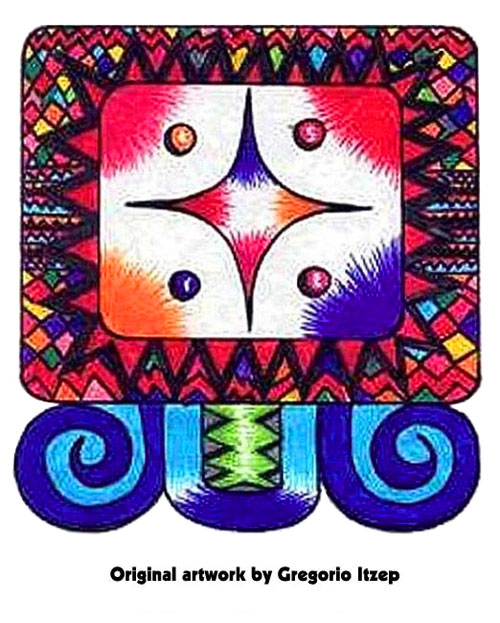
Lamat Trecena
by Kenneth Johnson
Though the meaning of the Yucatec Mayan word lamat is unknown, the significance of this daysign is clear. It is a symbol of ripeness, abundance, and the growth of the corn. Lamat represents the four colors of corn which are in turn symbolic of humanity and its four colors – red, black, white and yellow. It is the creative energy of Mother Nature herself. The K’iche’ name for this day-sign, Q’anil, is derived from q’an, the common word for the color yellow, and it means a “yellowing” or a “ripening,” the ripening or maturation of crops, of human beings, and of ideas. Lamat signifies the seed, corn, pride, harvest, and food. It is the nawal of all kinds of animal and vegetable seeds. It is the day of fertility and harvests, abundance, prosperity; this is an auspicious day for initiating any planting or business negotiation. Lamat is the archetype of the seed that sprouts after being planted in the rich earth. As with the earth, so with the human beings who live upon her body. This is a day-sign of reproduction and birth, and thus a very sensuous, even sensual sign.
The Aztecs called this day-sign Rabbit. The rabbit in question would seem to be “the rabbit in the moon.” Whereas Westerners see a “man in the moon,” both the Chinese and the Native peoples of Mesoamerica saw a rabbit. This mythic rabbit is the companion of Mayahuel, the goddess of drinking. Mayahuel, it is said, was a virgin goddess under the protection of the celestial monster or Sky Serpent. Quetzalcoatl, in his cosmic form as the god of the wind, stole her from her guardian and fled with her to earth. He became one with her, and the two of them were transformed into a great tree with two branches: a male branch to represent Quetzalcoatl, and a female branch to represent Mayahuel. The Sky Serpent, angered, came with his celestial helpers and attacked the tree that held the spirit of his former ward. The female branch was torn to pieces: Mayahuel was dead. In sorrow, Quetzalcoatl returned to his customary form and buried the bones of the virgin goddess. From her grave sprouted the agave or maguey plant from which the liquor known as pulque is brewed.
The story of Mayahuel and Quetzalcoatl is an Aztec version of a myth common all over preColumbian America. The story of the goddess who dies, is buried, and returns in the form of growing things is fundamental to Native American mythology. It signifies that the earth is regarded as the physical body of the Divine Mother. In many versions of the myth it is corn, not agave, that grows from the body of the slain Earth Mother, as corn was the Native American “staff of life.”
The glyph for Lamat is one of the principal symbols of Mayan Spirituality. A Lamat glyph is laid out upon the ground in sugar to form the basis for the altar in the Mayan Fire Ceremony. Instead of the square frame shown here and in most glyphs from the codices, the Fire Ceremony altar is enclosed within a circle, which represents the circle of Time itself, the endless round of the days of the tzolk’in. The cross is the symbol of the four directions that make up a wholeness, and of all its nuances – the colors of corn, of humanity, the four elements, and so on. Within each quadrant is depicted yet another circle. Those who are familiar with the Chinese yin-yang symbol which is so important in Taoism will know that it represents yin within yang and yang within yin – in other words, the opposite energies of the universal polarity are not disconnected or separate, but include each other and interpenetrate with each other. In this Mayan symbol, the circles within each quadrant convey the same message. The four directions of the Medicine Wheel and of the world we live in are not isolated or separate forces; rather, each direction contains within itself yet another circle of wholeness, or completeness.
This day-sign may also be said to have an association with the planet Venus, for during the Classic Period and in the Post-Classic codices of Yucatan, the Lamat symbol also signifies Venus. The codices make it clear that the rising and setting times of Venus were an important indicator of agricultural cycles and rainfall to the ancient Maya.
This is a wonderful time for farmers or simple planter box gardeners, for at this time we ask that the world may be made to blossom and be made fertile. We may plant ideas and projects as well as flowers; any relationship or business venture which begins on a Lamat day will usually turn out favorably. We, as humans, participate in the abundance of the world; we are not separate from it.
http://www.jaguarwisdom.org

